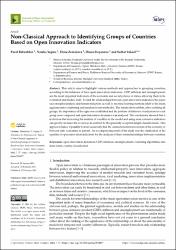| dc.contributor.author | Baboshkin, Pavel | |
| dc.contributor.author | Yegina, Natalya A. | |
| dc.contributor.author | Zemskova, E. S. | |
| dc.contributor.author | Stepanova, Diana I. | |
| dc.contributor.author | Yüksel, Serhat | |
| dc.date.accessioned | 2021-05-24T06:39:22Z | |
| dc.date.available | 2021-05-24T06:39:22Z | |
| dc.date.issued | 2021 | en_US |
| dc.identifier.citation | Baboshkin, P., Yegina, N. A., Zemskova, E. S., Stepanova, D. I. ve Yüksel, S. (2021). Non-classical approach to identifying groups of countries based on open innovation indicators. Journal of Open Innovation: Technology, Market, and Complexity, 7(1), 1-27. https://dx.doi.org/10.3390/joitmc7010077 | en_US |
| dc.identifier.issn | 2199-8531 | |
| dc.identifier.uri | https://dx.doi.org/10.3390/joitmc7010077 | |
| dc.identifier.uri | https://hdl.handle.net/20.500.12511/6888 | |
| dc.description.abstract | This article aims to highlight various methods and approaches to grouping countries, ac-cording to the behavior of their open innovation indicators. GDP, inflation and unemployment are the most important indicators of the economic and social policies of states, allowing them to be evaluated and models built. To find the relationships between open innovation indicators the paper uses marginal analysis and feature reduction, as well as machine learning methods (shift to the mean, agglomerative clustering and random forest methods). The results showed that, after isolat-ing all groups, the importance of the signs was established and the patterns of behavior of indicators for each group were compared and open innovation dynamics was analyzed. The conclusions showed that it is obvious that increasing the number of variables in the model and using more ex-tensive indicators can greatly increase the accuracy, in contrast to the generally accepted simple classifications. This approach makes it possible to more accurately find the connections between sectors of the economy or between state economies in general. An accompanying result of the study was the clarification of the equality of open innovation indicators for the analysis of their interrela-tionships between countries. | en_US |
| dc.language.iso | eng | en_US |
| dc.publisher | MDPI AG | en_US |
| dc.rights | info:eu-repo/semantics/openAccess | en_US |
| dc.rights | Attribution 4.0 International | * |
| dc.rights.uri | https://creativecommons.org/licenses/by/4.0/ | * |
| dc.subject | Open Innovation Dynamics | en_US |
| dc.subject | GDP | en_US |
| dc.subject | Inflation | en_US |
| dc.subject | Unemployment | en_US |
| dc.subject | Clustering Algorithms | en_US |
| dc.subject | Random Forest | en_US |
| dc.subject | Country Classification | en_US |
| dc.title | Non-classical approach to identifying groups of countries based on open innovation indicators | en_US |
| dc.type | article | en_US |
| dc.relation.ispartof | Journal of Open Innovation: Technology, Market, and Complexity | en_US |
| dc.department | İstanbul Medipol Üniversitesi, İşletme ve Yönetim Bilimleri Fakültesi, Uluslararası Ticaret ve Finansman Bölümü | en_US |
| dc.authorid | 0000-0002-9858-1266 | en_US |
| dc.identifier.volume | 7 | en_US |
| dc.identifier.issue | 1 | en_US |
| dc.identifier.startpage | 1 | en_US |
| dc.identifier.endpage | 27 | en_US |
| dc.relation.publicationcategory | Makale - Uluslararası Hakemli Dergi - Kurum Öğretim Elemanı | en_US |
| dc.identifier.doi | 10.3390/joitmc7010077 | en_US |
| dc.identifier.scopusquality | Q1 | en_US |



















